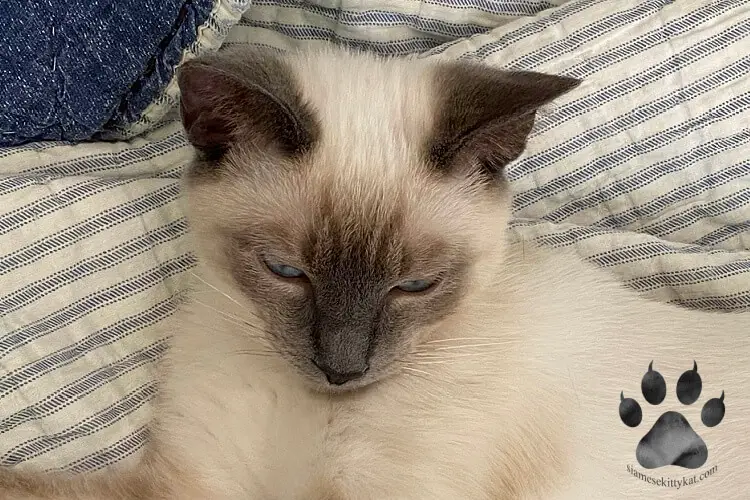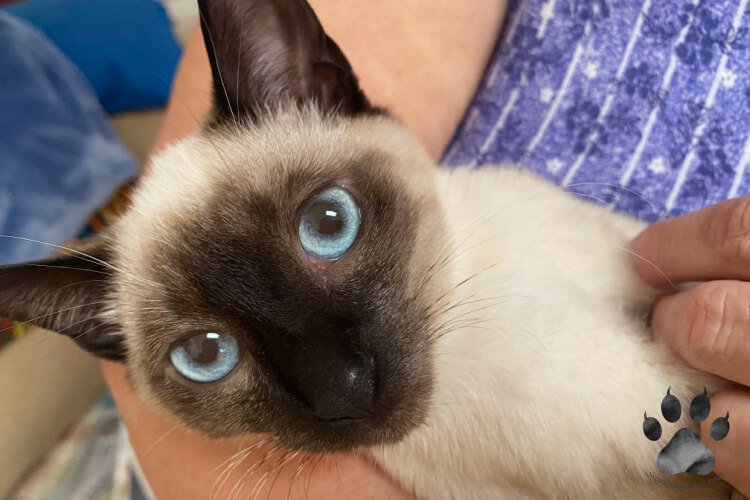Cats, according to a famous saying, are “little people in fur coats.” One thing that sets cats apart is their fur’s luxuriousness. Did you know that their fur can tell us if something is wrong with their health?
The condition of your Siamese cat’s fur can tell you any health issues he may be experiencing.
Our Siamese cats cannot communicate directly with us when they are ill. This is why we look for hints like changes in their outward appearance and behavior patterns. The texture of our cat’s coats can give clues about their health. Their grooming behaviors determine if they have a healthy or unhealthy coat.
Searching for fur signs helps detect developing health issues before they become severe. We can treat these before they worsen when we detect them early. This ensures they do not cause irreparable harm to our cats.
What does the condition of your cat’s fur reveal about his health? Keep reading, as we will talk about that in this article.
How Can I Tell If My Siamese Cat’s Fur Is Healthy?
Your Siamese cat’s fur is healthy and in good condition when it is soft and lustrous. It is not greasy, despite its shiny appearance.
You can tell if the fur is in good condition by touching it with your hands.
Your cat’s fur is neither rough nor granular in texture. It is not bumpy, either.
There are several ways in which we can maintain the health and softness of their fur. You can keep your cat’s coat shiny and healthy if you stick to these ways.
Why Does My Cat’s Fur Look Unhealthy?
Grooming is a daily ritual for Siamese cats. They enjoy grooming, so it is worrisome when their fur seems unhealthy.
Your cat’s fur gives off an unhealthy look if it becomes coarse or matted. Another sign is if your cat starts to get bald spots.
Fur loss is one of the most obvious indications that your cat’s fur is unhealthy. Another warning sign is that your cat constantly scratches. You will also notice scaling and crusting if the fur problem gets severe.
What are the causes of unhealthy fur? Fixing it will be a breeze when we know what is causing the issue.
The following are the most frequent causes of a Siamese cat’s unhealthy-looking fur:
1. Chronic Illnesses
2. Fleas
3. Lumps or tumors
4. Skin parasites
5. Skin infection
6. Poor grooming
7. Poor dietary habits
8. Dental problems
9. Malnutrition
10. Obesity
What Does A Sick Siamese Cat’s Fur Look Like?

1. Rough, spotted fur
Rough, spotted fur tells you your cat is underweight or malnourished. Other signs that your cat lacks nourishment are dry, scaly skin and weak muscles.
Your Siamese cat loses motivation to groom himself because his muscles feel weak. He needs to see a vet right away when this is the situation. Your vet can assist you if your Siamese cat has little to no appetite.
Also, make sure your cat gets enough food and water daily. Your cat becomes weak and undernourished after two to three days without food and water.
2. Greasy, knotted coat
Hyperthyroidism can cause your cat’s fur to become greasy and tangled. Unhealthy-looking fur often precedes weight loss when a cat has hyperthyroidism.
Your cat may also have hyperthyroidism if he drinks too much and urinates more often than usual. Your cat may experience diarrhea and vomiting as well.
You should pay attention to it if your Siamese cat has a smooth, knotted coat. Your cat could experience kidney damage and hypertension due to possible hyperthyroidism. Get him treatment if he has hyperthyroidism to prevent complications.
3. Dull coat and skin patches
A dull coat and patches all over a cat’s body could mean he has seborrhea. Your cat’s skin may also have an unpleasant smell, along with his dull coat and scaly skin.
Seborrhea can manifest on your Siamese cat’s face, back, and skin folds. It mainly affects your cat’s skin along the back. It usually affects skin areas with high concentrations of sebaceous glands.
Scaly, white patches, like dandruff, peel off in the affected areas of his skin. The fur’s quality reduces due to the scaling. Most felines affected by seborrheic dermatitis also have dry, greasy coats.
Your Siamese cat’s seborrhea can clear up with a medicated shampoo. His coat condition can improve with topical treatments that target scaling skin.
4. Unkempt fur
Unkempt fur could be a sign of osteoarthritis.
Osteoarthritis can occur for a variety of reasons in Siamese cats. Among these are joint infections, being overweight, damaged ligaments, and muscle injuries.
Your Siamese cat could have osteoarthritis if he walks stiffly. Osteoarthritis makes moving around and standing up and down tricky for your cat. His joints are also sore or swollen.
The weakness of your Siamese cat’s joints hinders his meticulous grooming routine. Your kitty avoids grooming because moving can be painful due to his swollen joints.
A lack of care for his grooming routine increases the likelihood that his fur will become dry and untidy.
Osteoarthritis is a complicated condition. It is best to seek professional veterinary care for treatment. Never give any pain relief medicine to your cat without talking to your vet first.
Ask your vet what you should feed your Siamese cat and what medicines he should take. Your vet will suggest a supplement and pain medication to help your cat recover.
5. Greasy, untidy fur
Greasy, untidy fur indicates that your cat is suffering from pneumonia. Lethargy is a pneumonia symptom that influences your cat’s grooming routine.
Your Siamese cat does not have enough energy to groom himself if he has pneumonia. Your cat also loses his appetite. Other indications of pneumonia are heavy breathing and a dry cough.
6. Heavy shedding of fur
Shedding excessive amounts of fur indicates anxiety or stress in Siamese cats.
All cats go through their unique shedding cycles. There are some cats, though, that shed more than the average. Their stress levels may be contributing to their excessive shedding.
Your Siamese cat may be experiencing stress if he is often shedding clumps of fur. You may notice that your cat grooms himself less often than usual whenever he is stressed. His fur becomes dry and tangled as a result.
Your cat often hides and backs away from you, shedding a lot and having damaged fur. You might also notice that he has been overeating and scratching more than usual.
What Does A Dull Coat On A Siamese Cat Mean?

It is upsetting when our cats’ soft, lustrous fur loses its luster. There are several causes for this problem.
A greasy, dull coat indicates that your Siamese cat is anxious and under stress. A dull coat may also mean that your cat has dental issues. Besides that, excessive shedding can make your cat’s fur appear matted and dull.
A dull, matted coat could imply that your Siamese cat has an allergy or skin infection. Your cat may also have a dull, matted coat and flaky skin when he is not getting enough nutrition.
What Makes A Siamese Cat’s Coat Soft?
There are many layers in your Siamese cat’s fur, which is why it’s soft to the touch. The multilayered fur on your cat makes him super plush and comfortable to pet.
Your Siamese cat’s grooming routine contributes to his fur’s softness. Regular grooming makes his fur soft, silky, and healthy.
Another factor affecting the softness of your cat’s fur is the nutritional value of his diet. Your cat’s coat improves in texture when he eats well-balanced, nutritious meals.
Your Siamese cat’s emotional responses can also influence the feel of his fur. You will notice this because when your cat is happy, his fur will have a luxurious, smooth texture. His fur becomes dry and stiff when he is unhappy or under stress.
Furthermore, there are different cat breeds, each with its unique fur texture. Their genetic makeup determines their fur pattern and texture they have.
A few other cat breeds have more fluffy and soft fur than others. Persians, Ragdolls, Himalayans, Ragamuffins, and Maine Coons are among the softest-furred cat breeds.
How Can I Improve My Siamese Cat’s Fur?
We gathered all the health tips tailored towards maintaining your Siamese cat’s optimal well-being. Check it out here: Siamese Cat Health: A Complete Guide

